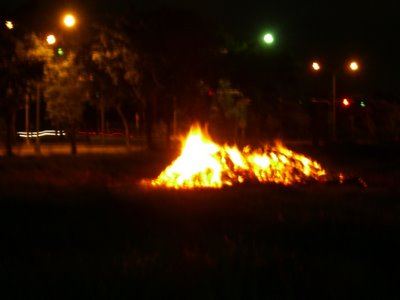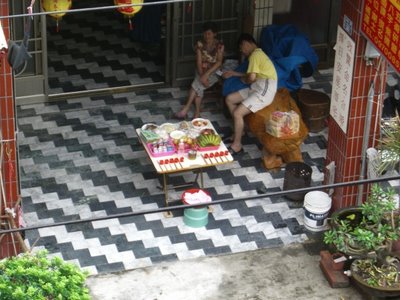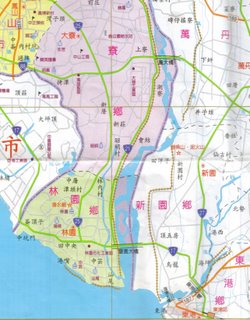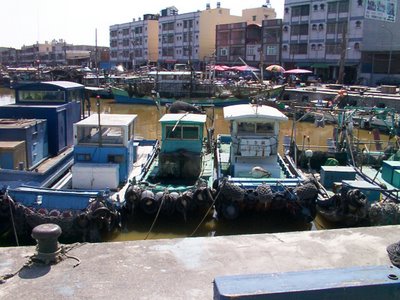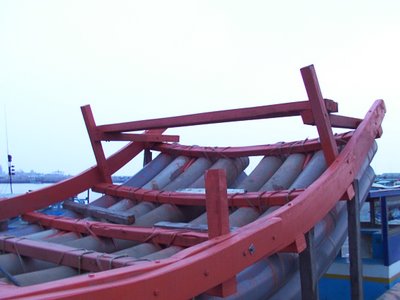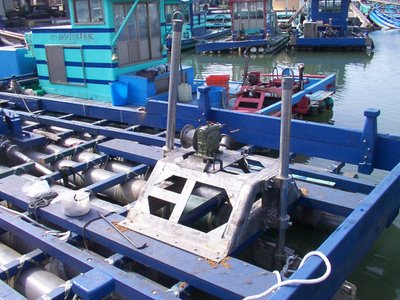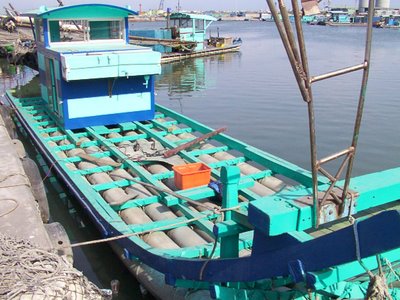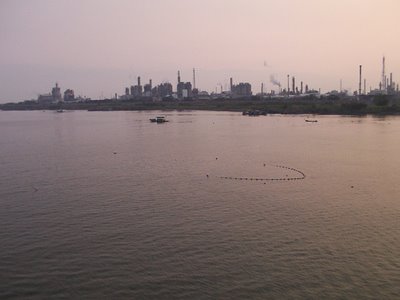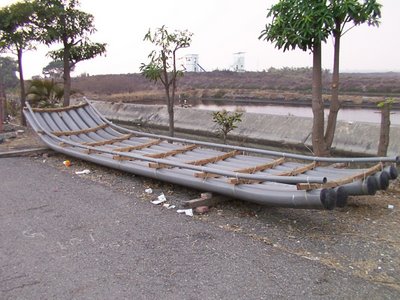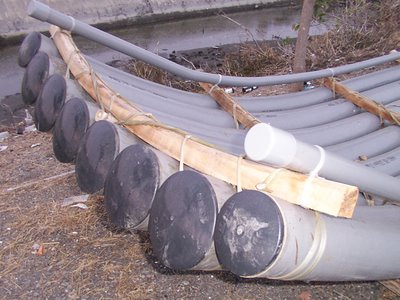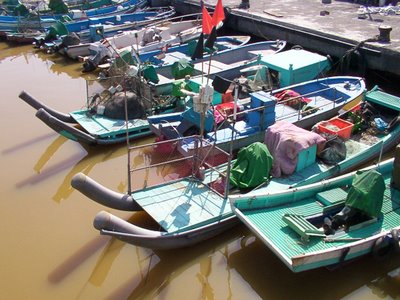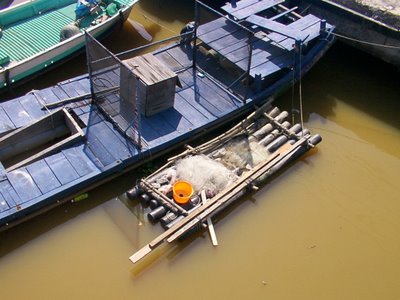Fever all through the night. -E. Cooley/J. Davenport 1956
 Though China's booming economy is so often celebrated in the news these days, often to the exclusion of everything else, Taiwan's industrial rise as one of the "Asian Tigers" followed a similar trajectory in the 80's and 90's. As living standards rose, families quickly abandoned their bicycles and took to the road on motorscooters.
Though China's booming economy is so often celebrated in the news these days, often to the exclusion of everything else, Taiwan's industrial rise as one of the "Asian Tigers" followed a similar trajectory in the 80's and 90's. As living standards rose, families quickly abandoned their bicycles and took to the road on motorscooters. Public transportation was slow to respond to the new demographics, and people needed a practical way to get to their new economy jobs in the city. The scooter was the answer.
Public transportation was slow to respond to the new demographics, and people needed a practical way to get to their new economy jobs in the city. The scooter was the answer. Public transportation, with the exception of a high-speed rail system connecting Kaohsiung and Taipei, and the MRT light rail systems of each city are still trying to catch up with the transportation needs of the island. Gasoline has been heavily subsidized as a stop-gap measure, and as the economy continued to grow, so did car ownership. The government-owned China Petroleum Company recently lifted its cap on fuel prices after the presidential election in May 2008, once again sending people back out on the road on scooters in greater numbers than ever before.
Public transportation, with the exception of a high-speed rail system connecting Kaohsiung and Taipei, and the MRT light rail systems of each city are still trying to catch up with the transportation needs of the island. Gasoline has been heavily subsidized as a stop-gap measure, and as the economy continued to grow, so did car ownership. The government-owned China Petroleum Company recently lifted its cap on fuel prices after the presidential election in May 2008, once again sending people back out on the road on scooters in greater numbers than ever before. As an American man, my natural instinct is to look down on scooters. First off, they're for girls, as the stereotype in the West goes, and no real man would ever be caught "riding bitch" as Taiwanese men so commonly do. Secondly, and more objectively, the poor handling characteristics which derive from its tiny wheels and high sprung weight make it uncomfortable and unpleasant to ride.
As an American man, my natural instinct is to look down on scooters. First off, they're for girls, as the stereotype in the West goes, and no real man would ever be caught "riding bitch" as Taiwanese men so commonly do. Secondly, and more objectively, the poor handling characteristics which derive from its tiny wheels and high sprung weight make it uncomfortable and unpleasant to ride. Taiwanese love them for their carrying capacity and simplicity of operation. It's not uncommon to see a whole family on one. In fact, I've counted up to five people on a scooter at the same time. Mothers take the kids to school on scooters, or If you're a farmer, you can put a slaughtered pig on the footboard and bring it to market. You can carry a tv on the back.
Taiwanese love them for their carrying capacity and simplicity of operation. It's not uncommon to see a whole family on one. In fact, I've counted up to five people on a scooter at the same time. Mothers take the kids to school on scooters, or If you're a farmer, you can put a slaughtered pig on the footboard and bring it to market. You can carry a tv on the back. From what I've seen, dogs love scooters too. Lap dog owners might put their little poopsies in the basket at the front, or have them stand on their lap with their paws on the dashboard. Larger dogs can stand or lie on the footboard, jumping off and on as they prefer. Best of all, dog owners can use a scooter to "walk" their dogs without the inconvenience of actually having to walk themselves!
From what I've seen, dogs love scooters too. Lap dog owners might put their little poopsies in the basket at the front, or have them stand on their lap with their paws on the dashboard. Larger dogs can stand or lie on the footboard, jumping off and on as they prefer. Best of all, dog owners can use a scooter to "walk" their dogs without the inconvenience of actually having to walk themselves! The drivetrain of a scooter is a CVT, a simple automatic transmission consisting of a belt and two pulleys. This means that you can ride your scooter with one hand on the throttle and talk on the phone at the same time. You can ride, talk on the phone and smoke at the same time, too. You can also ride, talk on the phone, smoke, and chew betelnut at the same time, keeping the plastic cup which serves as a spittoon on the footboard or between your knees. Furthermore, You can ride, talk on the phone, smoke, chew betelnut, spit, and ride two abreast with another scooter as your passengers smoke, chew betlenut, and bellow out a conversation to each other.
The drivetrain of a scooter is a CVT, a simple automatic transmission consisting of a belt and two pulleys. This means that you can ride your scooter with one hand on the throttle and talk on the phone at the same time. You can ride, talk on the phone and smoke at the same time, too. You can also ride, talk on the phone, smoke, and chew betelnut at the same time, keeping the plastic cup which serves as a spittoon on the footboard or between your knees. Furthermore, You can ride, talk on the phone, smoke, chew betelnut, spit, and ride two abreast with another scooter as your passengers smoke, chew betlenut, and bellow out a conversation to each other. An important part of the scooter-borne demographic which should be mentioned is the "scooter punk". For reasons of it's low power and atrocious handling characteristics, the scooter should be the least obvious choice for high-performance or racing enthusiasts.
An important part of the scooter-borne demographic which should be mentioned is the "scooter punk". For reasons of it's low power and atrocious handling characteristics, the scooter should be the least obvious choice for high-performance or racing enthusiasts. I seem to remember someone telling me that scooter racing from Japan is televised here, but I'll need to ask my fact checker about that. Despite all this, the aftermarket accessory market thrives. Popular modifications include louder, higher flow exhausts, transmission mods to increase accleration, and lights, including flashing strobe lights. Taiwan-based Kymco even offers several stock "racing" models which have larger displacement engines, more agressive styling, and disk brakes. Mirrors are specified in the Taiwan motor vehicle code, but removing them to achieve a racy look is the most popular modification. It's also the cheapest.
I seem to remember someone telling me that scooter racing from Japan is televised here, but I'll need to ask my fact checker about that. Despite all this, the aftermarket accessory market thrives. Popular modifications include louder, higher flow exhausts, transmission mods to increase accleration, and lights, including flashing strobe lights. Taiwan-based Kymco even offers several stock "racing" models which have larger displacement engines, more agressive styling, and disk brakes. Mirrors are specified in the Taiwan motor vehicle code, but removing them to achieve a racy look is the most popular modification. It's also the cheapest. Youthful enthusiasm and indiscretion account for lots of stupid and agressive driving behavior everywhere, as we all know, but this is especially true in Taiwan, where law enforcement is apathetic at best. There's a national helmet law, which was partly inspired by a national epidemic of scooter-related head injuries. Here in Zhao Ming hardly anyone wears a helmet. Scooter commuters to the city will often stow a helmet onboard, and then simply plop it on their head, straps flying, once they have reached the city limits.
Youthful enthusiasm and indiscretion account for lots of stupid and agressive driving behavior everywhere, as we all know, but this is especially true in Taiwan, where law enforcement is apathetic at best. There's a national helmet law, which was partly inspired by a national epidemic of scooter-related head injuries. Here in Zhao Ming hardly anyone wears a helmet. Scooter commuters to the city will often stow a helmet onboard, and then simply plop it on their head, straps flying, once they have reached the city limits.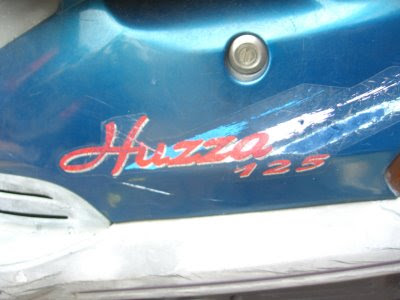 I've been told that people in Taiwan have more freedom than in the US. Huzza! Enjoy your freedom! Get all the freedom you can, and don't worry about where yours begins and others' ends.
I've been told that people in Taiwan have more freedom than in the US. Huzza! Enjoy your freedom! Get all the freedom you can, and don't worry about where yours begins and others' ends.Until next time, stay safe and count your blessings, every one.
-Jie Ke











